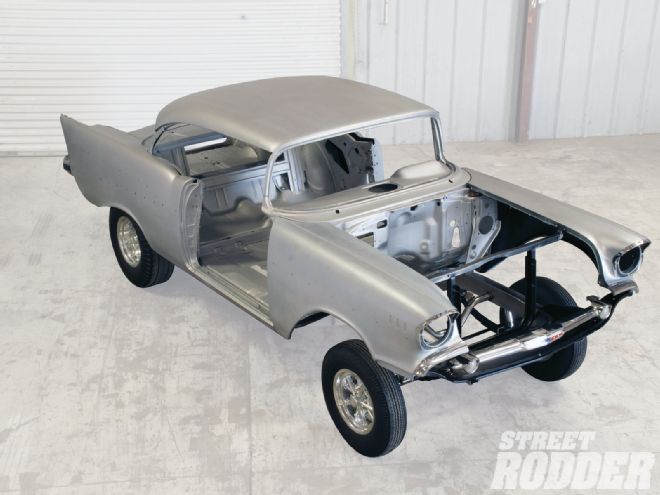
Every time I see a new, all-steel reproduction body I take a serious reality check. Had someone mentioned 35 years ago that one day all-new steel bodies would be available we would have scoffed at the idea. After all, this was a time when you could barely get a patch panel that actually fit your car, let alone an entire replacement body. If you were working on a ’50s or ’60s car, OEM replacement panels were the only way to fly, and even back then they were becoming both pricey and scarce. But an entire body? Never happened. Ah, but never is a long time and Woody’s Hot Rodz has “shortened” never into now.
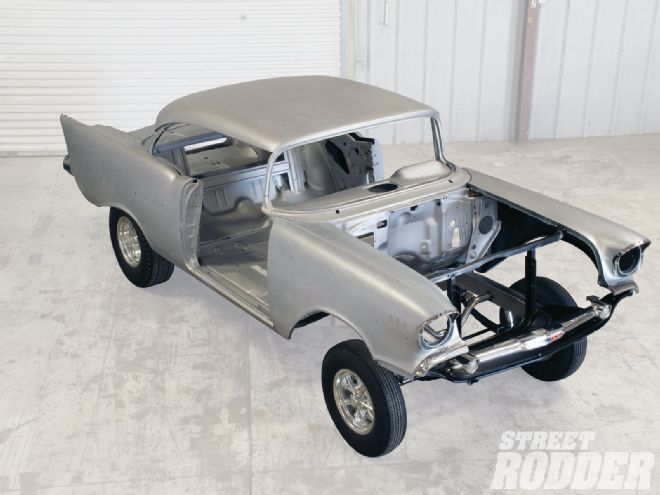 If Chevrolet is truly the Heartbeat of America, this should quicken the pulse. Suddenly building a ’57 Chevy just got a whole lot easier, thanks to Real Deal Steel bodies through Woody’s Hot Rodz.
If Chevrolet is truly the Heartbeat of America, this should quicken the pulse. Suddenly building a ’57 Chevy just got a whole lot easier, thanks to Real Deal Steel bodies through Woody’s Hot Rodz.
By the turn of the century there were several all-steel reproduction bodies on the market. It began with Model A, and then of all things a ’32 Chevrolet roadster, and progressed to the ’32 Ford, then the ’33-34 Ford, and Waddington’s Model A closed-cab pickup. Next, first-generation Camaro bodies was being assembled and now we have actually watched the entire assembly of a ’57 Chevrolet Bel Air convertible and hardtop body, complete from headlight to tailfin. Finally, came Bob Drake’s ’40 Ford coupe.
So how exactly do we come from being unable to find reasonable replacement panels to top-quality entire steel bodies? Well, two things come into play: a shrinking world and the computer—but not necessarily in that order. Technology has changed so dramatically over the past 20 years that many projects once deemed financially impossible are now a reality. Offshore manufacturing has also provided us with competitive pricing on big projects, such as reproducing ’55-57 Chevrolet bodies. Technology has made it possible to “reverse engineer” parts, a process where a perfect original piece can be 3-D scanned and put into production faster and cheaper than ever before.
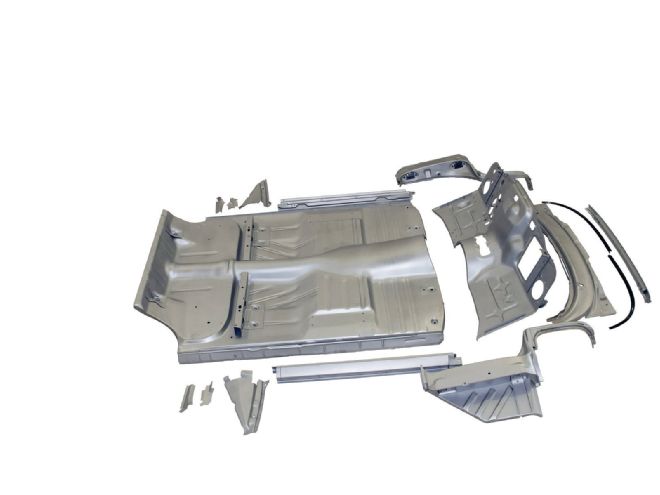 Laid out in an orderly fashion, we can see that these are high-quality stampings. This is the front section of the floor, rockers, and complete cowl.
Laid out in an orderly fashion, we can see that these are high-quality stampings. This is the front section of the floor, rockers, and complete cowl.
Like most steel body builds, this one did not begin as one cohesive project to build a complete Tri-Five Chevrolet body. Much like the Camaro body, it began with replacement panels, such as floors, rocker panels, quarter-panels, doorskins, and fenders. These panels were first stamped to help enthusiasts repair old and rusted vehicles. Anyone who has ever repaired a rusted car knows rust is seldom skin deep and rust never sleeps. Peel back that rusted quarter-panel and you will likely find rotted wheelhouses and floors. And so, more and more parts were being produced to repair the original cars. Enthusiasts soon realized they were better off purchasing a complete replacement door rather than simply a doorskin. Floorpan and foot well patch panels soon gave way to complete floor replacements. Structural rust in the firewall area brought with it demand for a complete cowl section in stock form, particularly for convertibles. It was about this time the concept of a complete ’57 Chevy body became realistic. If they manufactured roof skins, inner roof structures, and complete inner quarter-panels they could assemble a complete car.
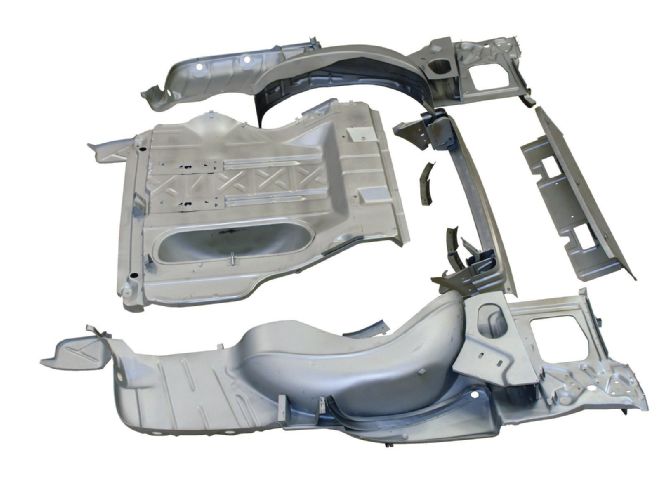 The rear section is a bit more complicated with inner quarter-panels, crossbraces, and the trunk floor. On surviving original cars, virtually all of these panels would be rusted.
The rear section is a bit more complicated with inner quarter-panels, crossbraces, and the trunk floor. On surviving original cars, virtually all of these panels would be rusted.
And so the stamping continued, until this year when every brace, inner panel, and exterior panel was finally stamped in brand-new steel. The next major project was the fabrication of fixtures to precisely assemble complete car bodies. This body is an exact reproduction of the original, which means if you find a good set of doors, a decklid, or front clip on a parts car they will bolt right on this body.
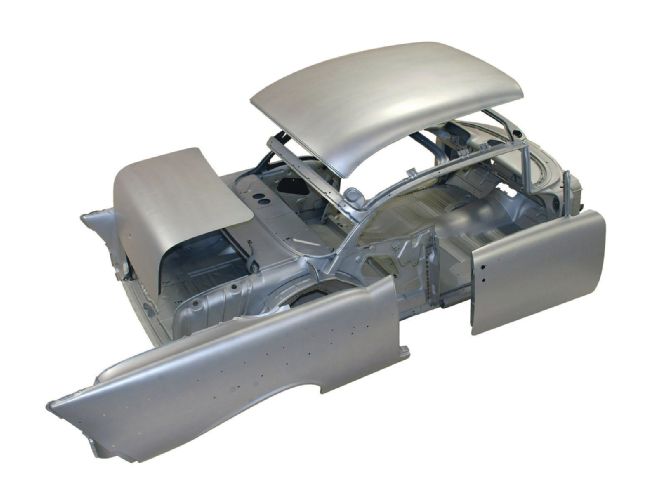 Every piece of external sheetmetal is also available and this is how it all goes together, somewhat like a giant model. Quality is very high throughout the body building process.
Every piece of external sheetmetal is also available and this is how it all goes together, somewhat like a giant model. Quality is very high throughout the body building process.
The steel is all stamped in Taiwan to a very high standard. Every panel has been reverse engineered from perfect original parts and there have been a few improvements along the way; things like the one-piece floor. The original Tri-Five Chevrolet didn’t have a seam down the center of the transmission tunnel. Current aftermarket floorings are two-piece with a seam. However the new Real Deal Steel floorings do not have a seam mimicking the original factory floor. On these new bodies the floor is one big stamping, eliminating the center seam and enhancing the strength of the floor in the process.
We had heard rumors of the new Real Deal Steel Tri-Five Chevrolet bodies since last summer and when Chris Sondles of Woody’s Hot Rodz contacted us about his new ’57 steel body and chassis packages we had to get a firsthand look at the project.
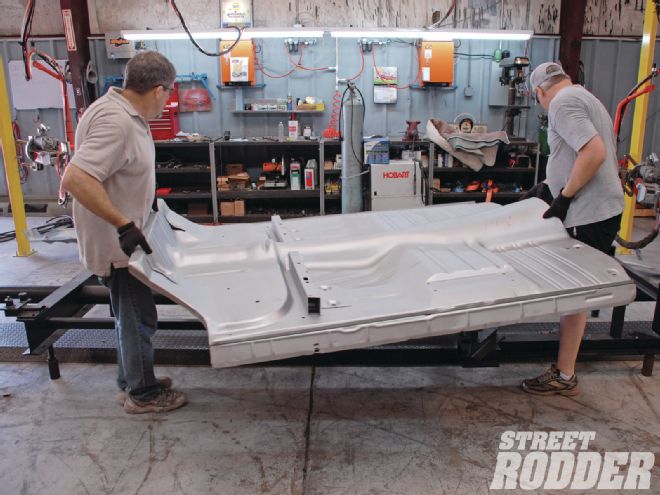 So let’s get started. First the front floor panel is lifted onto the precision building fixture. This fixture locates the floor and also can be raised and rotated to ease assembly.
So let’s get started. First the front floor panel is lifted onto the precision building fixture. This fixture locates the floor and also can be raised and rotated to ease assembly.
This brought us to the Real Deal Steel body plant in Sanford, Florida, where we met the men behind the bodies, Joe Whitaker and Randy Irwin. Walking inside the manufacturing building we were greeted by no less than five Real Deal Steel bodies in different levels of completion. Talking about these bodies is one thing, walking up and actually looking at a brand-new ’57 Chevrolet convertible is a whole other story. These bodies are simply gorgeous.
Of course the fact that Chris Sondles arrived the day before we did and had one of the new hardtop bodies perched atop his wild, straight-axle ’57 reproduction frame only fueled the Tri-Five flames.
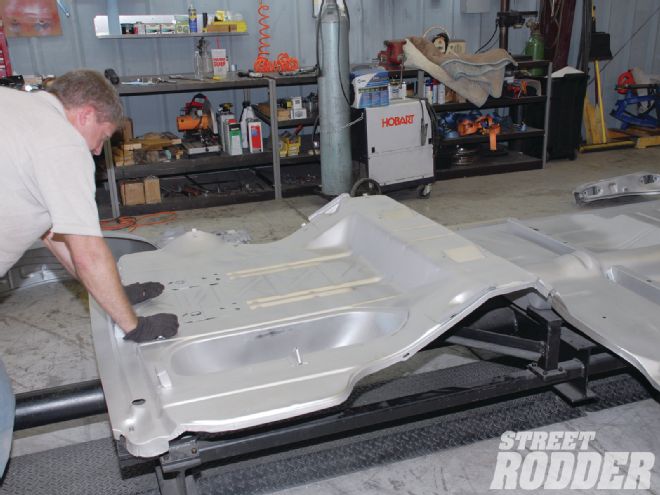 Next the rear floorpan panel is placed on the fixture. Bolts go through the ’57 Chevy body mounts on the floorpan and pull down tight to the fixture, ensuring a perfect fit.
Next the rear floorpan panel is placed on the fixture. Bolts go through the ’57 Chevy body mounts on the floorpan and pull down tight to the fixture, ensuring a perfect fit.
The Manufacturing Process
Now, Chevrolet built 1,515,177 total cars in 1957, yeah, roughly 1.5 million cars, over 4,000 per day. Needless to say that is just a bit above the capacity of the Real Deal Steel company, but still their single production station is impressive and the productivity is ample to fill the needs of our hobby, turning out a couple bodies per week.
One of the keys to maintaining high quality and keeping the price within reach is the fact that these bodies are assembled in the United States. After the stamping process is completed in Taiwan they are loaded into a shipping container and are transported by ship. That same container is then delivered by truck to Real Deal Steel for assembly. This enables them to put 30 bodies in one container, saving a tremendous amount of shipping cost in the process, costs that would have been passed onto the end consumer. To illustrate just how much is saved that same container that holds enough parts for 30 bodies would hold just two complete bodies.
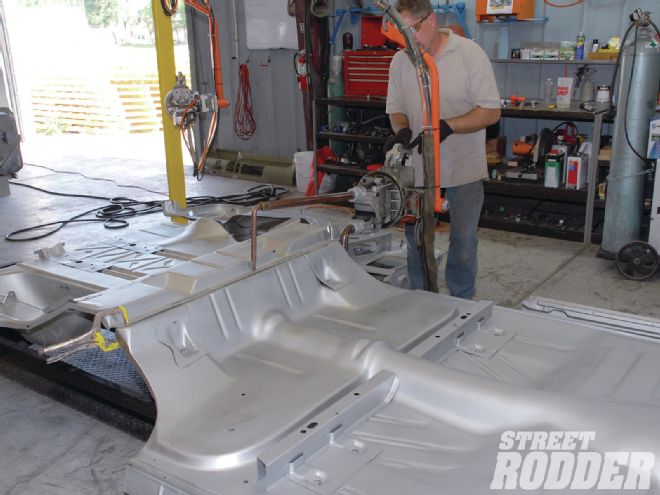 Using a spot-welder much like automakers use, Joe Whitaker spot-welds the front and rear floorpans together. The new front floorpan is a one-piece stamping, no center seam required.
Using a spot-welder much like automakers use, Joe Whitaker spot-welds the front and rear floorpans together. The new front floorpan is a one-piece stamping, no center seam required.
The panels arrive in boxes on pallets and after the stamping, every panel is coated with a proprietary silver coating. This is a weld-through primer that prevents rust but allows perfect welding too. The silver color gives the car a real steel body look.
Each body is assembled by hand on a precise fixture that ensures each body will be the same. First the floor sections are mounted to the base fixture and the front half of the floor is spot-welded to the rear portion using a production-style spot welder, much like you would see on a modern automotive assembly line. Additional welding is done with a MIG welder.
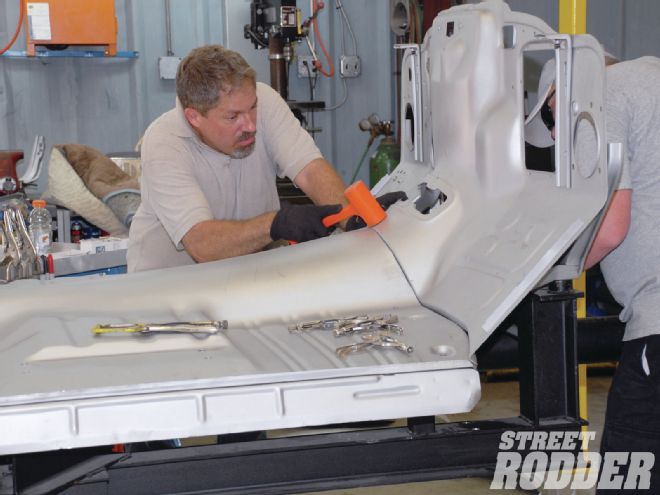 Next, the front foot well and firewall panel is installed. The piece slips into a slot on the floor so a bit of gentle persuasion is in order to set the firewall into the front floorpan.
Next, the front foot well and firewall panel is installed. The piece slips into a slot on the floor so a bit of gentle persuasion is in order to set the firewall into the front floorpan.
After the floor panels are connected a large (and heavy) fixture is installed atop the new floor panels. This fixture will locate the new firewall and inner cowl structure.
A second fixture is now bolted in place, connecting to both the main floor fixture and the front fixture. This jig precisely locates both inner quarter-panel structures. After locating the inner quarter-panels they too are spot-welded and MIG-welded in place, followed by the rocker panels that connect the inner cowl to the inner quarter-panel structures. A smaller windshield fixture is now bolted atop the forward fixture and the windshield surround is attached to the lower cowl area.
The inner fixture also locates the bracing connecting the two inner quarter-panels and the hinge points for the decklid. Of course the panels vary between the convertible and hardtop but the same base fixture is used for both bodies. After adding a myriad of other braces and inner panels the ’57 Chevrolet “skeleton” is complete. The good news is you can buy just the inner structure from Real Deal Steel and hang your own reproduction, N.O.S., or good used panels on this skeleton. If you had a decent parts car this could be the way to go. Original doors, decklids, quarter-panels, and the front clip will all weld or bolt to this skeleton just like an original car.
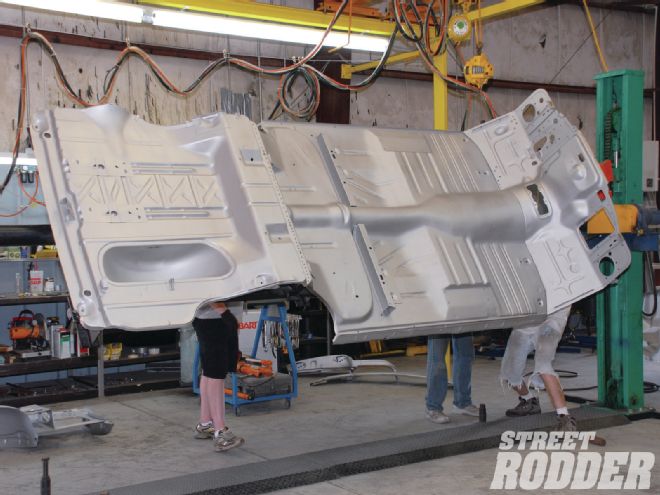 Here’s the completed floorpan, rotated for welding on the bottom side. If you live east of the Mississippi and are under 40, this may be the first Tri-Five Chevy floorpan you have ever seen without rust holes.
Here’s the completed floorpan, rotated for welding on the bottom side. If you live east of the Mississippi and are under 40, this may be the first Tri-Five Chevy floorpan you have ever seen without rust holes.
It is interesting to note that Whitaker and Irwin really expected to sell a lot of basic body skeletons, but that has not necessarily been the case. It seems most customers see the body with all the new outer skins installed and decide to go for the complete body.
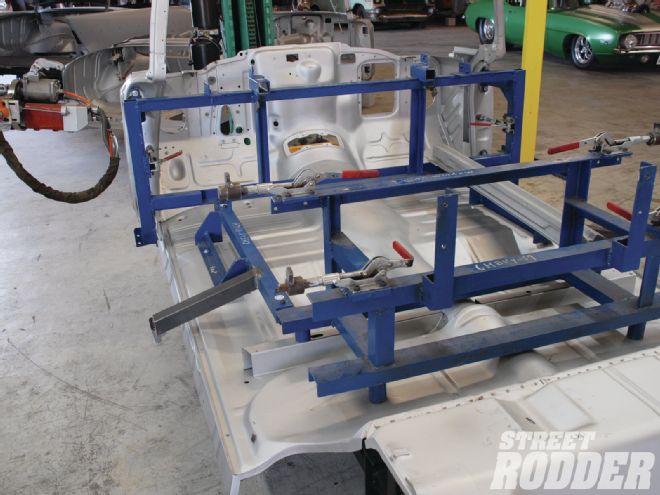 It takes some time and manpower to place the fixtures atop the floorpan. They are heavy and perfect alignment is ensured by multiple bolts holding them together.
It takes some time and manpower to place the fixtures atop the floorpan. They are heavy and perfect alignment is ensured by multiple bolts holding them together.
The complete body is manufactured while the car is still on the fixture. The quarter-panel skins are aligned and spot-welded in place just like the factory process. The fixture has locating pegs for the new outer quarter-panels so placement is precise. The panel between the quarters is then clamped in place. This panel incorporates the front of the driprail for the trunk area and is clamped to the new quarter-panels. Before this panel is welded in place, the new decklid is carefully fitted to the quarters and the forward panel. Once the decklid fits perfectly the spot welding continues to permanently attach all the panels. It should be noted that throughout the build there are approximately 25 percent more spot welds holding the body together than the original ’57 bodies.
The final panel to be installed is the lower tail pan and it too is fitted to the decklid prior to welding, along with the small inner quarter-panel pieces. This completes the body shell and the inner fixtures are removed from the body and the body is carefully lifted off the main fixture with a fork truck. If the customer has ordered doors, they are bolted in place at this time completing the body. Of course the hood, front fenders, inner braces, and brackets are all available in the complete package.
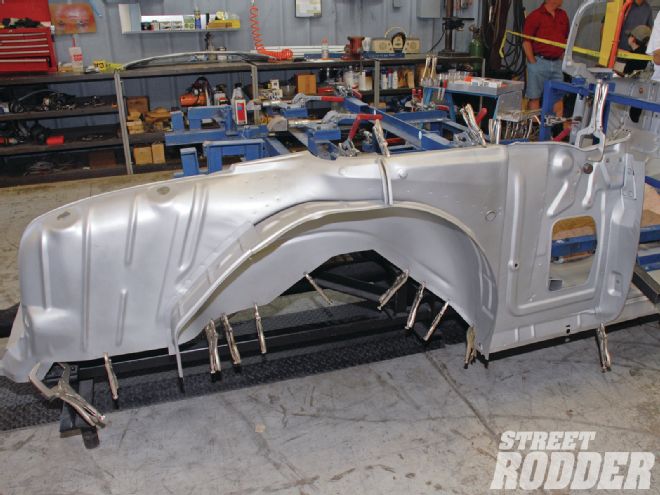 Moving back to the rear of the car it’s time to install the inner quarter-panel. This complex panel is bolted and clamped to the fixture for proper alignment.
Moving back to the rear of the car it’s time to install the inner quarter-panel. This complex panel is bolted and clamped to the fixture for proper alignment.
Different Stages of Completion
After watching the assembly process it is no real mystery to us why most people opt for the complete body package. Only the very best metalworkers could hang the quarters, rockers, and other panels with the precision that Real Deal Steel does. The fixture they use is just a huge advantage for alignment and the OEM-style spot welder makes it all look very original. While these bodies are manufactured by Real Deal Steel, they do not sell direct to consumers as they maintain their focus on manufacturing.
Woody’s Hot Rodz is the primary dealer for Real Deal Steel. Chris Sondles, owner of Woody’s, and the owners of Real Deal Steel have a working relationship that began over 20 years ago. They have spent the last two decades deeply involved with Tri-Fives and the bodies drop ship directly from the manufacturing facility in central Florida. You can purchase bodies from Woody’s Hot Rodz in virtually any state of completion and they also offer three different chassis to mount the Tri-Five Chevrolet: Woody’s straight-axle gasser style, a stock-like A-arm (upper and lower control arms) chassis, and of course an Art Morrison Enterprises chassis. Woody’s Hot Rodz is fast becoming the place for all your Tri-Five needs. They can provide the basic skeleton, a complete body, a complete body and frame kit, and even a complete painted body.
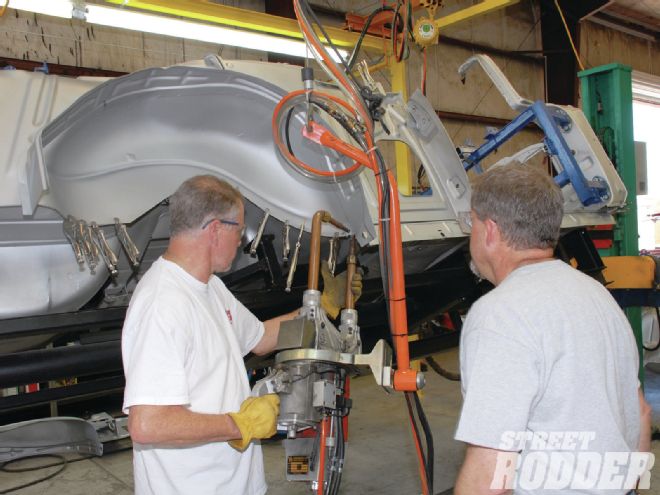 Certain that everything is lined up perfectly Randy Irwin begins the spot-welding process. There are 25 percent more spot welds used on the Real Deal Steel body than Chevrolet used in 1957.
Certain that everything is lined up perfectly Randy Irwin begins the spot-welding process. There are 25 percent more spot welds used on the Real Deal Steel body than Chevrolet used in 1957.
What it Means to the Hobby
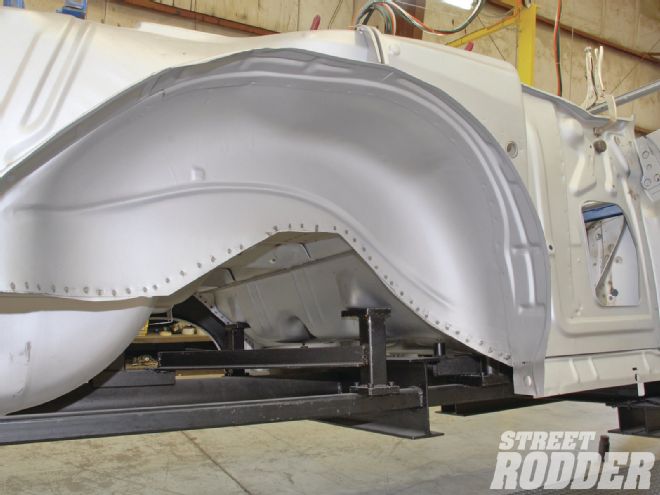 The finished inner fenderwell looks like a factory piece. Anyone who has ever repaired rusty wheel houses and inner quarter-panels will appreciate how great this looks.
The finished inner fenderwell looks like a factory piece. Anyone who has ever repaired rusty wheel houses and inner quarter-panels will appreciate how great this looks.
The introduction of all-new steel bodies for the wildly popular Tri-Five Chevrolets will obviously increase the number of ’55-57 Chevrolet hot rods. The Real Deal Steel ’55 and ’57 body through Woody’s will be available in a “post car” sedan model by the middle of the summer and the hardtop and convertible models are available now. After they complete the full line of ’57 Chevrolets (sorry, no Nomads) Real Deal Steel will begin assembling ’55 bodies in convertible, hardtop, and post styles. All ’56 models (sedan, hardtop, convertible) will be available by the spring of 2012.
While Tri-Five Chevrolets are not considered rare by most standards, they are very popular and that popularity drives demand, which keeps prices high, even for marginal cars. One interesting thing we have seen over the years is this: It is the customs, hot rods, and resto-mod cars that bring in the most money when sold. It is not uncommon for convertibles to be customized and modernized for maximum enjoyment and driveability. Tri-Five Chevrolets were hot-rodded long before anyone thought of restoring one and the advent of new steel bodies will provide hot rodders with a perfect body for everything from a straight-axle gasser to a low-slung custom. Of course the use of a new body for a resto-mod Chevrolet is a natural and dare we say these cars will find their way into the ranks of those people who had always dreamed of a stone-stock ’57 Chevrolet convertible. Of course you can also purchase any single part required to repair your original ’55-57 Chevrolet too. Suddenly that ’57 Chevy that was wrecked in the ’70s is now a repairable car with new inner structures and sheetmetal.
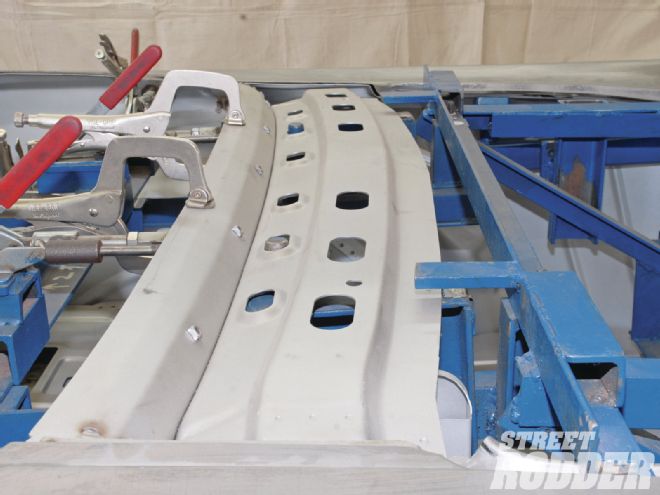 Next the brace that fits below the package shelf and between the quarter-panels is installed. This panel also holds the trunk hinges, and of course since this is a convertible the package shelf is replaced with a top well.
Next the brace that fits below the package shelf and between the quarter-panels is installed. This panel also holds the trunk hinges, and of course since this is a convertible the package shelf is replaced with a top well.
And all this serves to illustrate that the ’57 Chevrolet is a great-looking car that can be built in endless styles. Much like the venerable ’32 Ford, the Tri-Five Chevrolets are good looking in every body style and lend themselves to all styles of hot rodding. For those who think “everything has been done” on these cars, remember, they’ve been saying that about the Deuce for over 60 years.
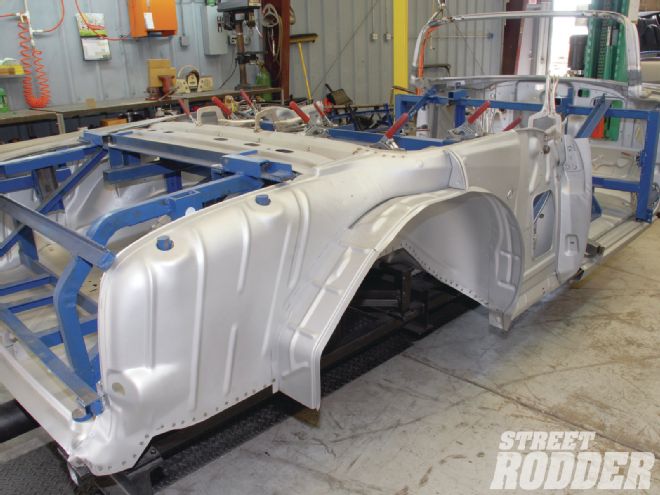 The entire inner skeleton is nearly complete. Real Deal Steel bodies through Woody’s are available as just a skeleton if you prefer to mount all of the external sheetmetal.
The entire inner skeleton is nearly complete. Real Deal Steel bodies through Woody’s are available as just a skeleton if you prefer to mount all of the external sheetmetal.
The advent of a brand-new body will now make building a ’57 Chevrolet much like building a Deuce. With reproduction frames available most hot rodders can assemble a high-caliber car in their home shop without the hassle of trying to rescue a 54-year-old rusted-and-tweaked body. And where you once felt compelled not to cut up that precious sheetmetal, you are now free to modify at will. Feel like doing the radiused wheelwell trick? Go ahead, there are plenty of quarter-panels to go around.
Bench racing sessions, emails, and online talk lead us to believe that the reproduction steel ’55-57 Chevrolet bodies may be the biggest thing to hit hot rodding since the steel Deuce roadster. As a matter of fact, most of us think these bodies will have an even bigger impact on our hobby as younger rodders relate to the mid-’50s cars. One thing is certain, this is a welcome addition to the multiple choices afforded hot rodders today. One need only remember the cars in the movie American Graffiti to understand the impact and the synergy.
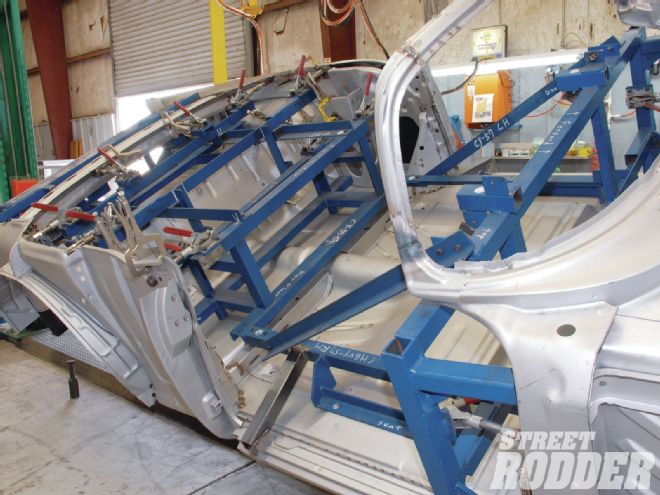 With the body rotated we can see the fixture system inside the structural panels. All of the red handles are cam-lock pins that push into designated holes to perfectly align everything.
With the body rotated we can see the fixture system inside the structural panels. All of the red handles are cam-lock pins that push into designated holes to perfectly align everything.
The Gasser Movement
It was bound to happen, gassers that is. After all, traditional hot rods have been the hot ticket for the past 10 years and nothing goes better with a traditional hot rod than an early gasser. Straight-axle cars, nose high stances, piecrust slicks, velocity stacks, and colored Plexiglas windows are all making a huge comeback. For many people, the term gasser and Tri-Five Chevrolets are synonymous, and we must admit few things quicken the pulse more than a straight-axle ’57 with no front bumper.
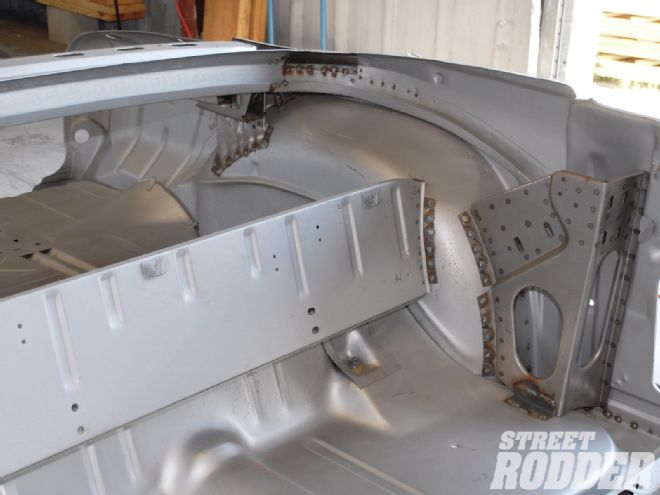 The rear seat brace is installed between the wheelhouses. The panel is plug welded in place with a MIG welder. The box panel on the wheelhouse holds the convertible top mechanism.
The rear seat brace is installed between the wheelhouses. The panel is plug welded in place with a MIG welder. The box panel on the wheelhouse holds the convertible top mechanism.
In the early ’60s, street-going gassers were every bit as common as traditional hot rods and just plain ol’ badass Tri-Five Chevrolets roamed the continent devouring the competition at the track and the “stop light grand prix.” Being of a certain age, this writer can remember watching gassers on the strip and roaming the streets. Nothing was more outrageous in the early ’60s than a straight-axle, nose-high fenderwells filled with headers, and radiused rear wheelwells gasser. Well, guess what? The same holds true today. Roll into your local cruise night or major national event with a rumbling gasser, rattling blue Plexiglas windows filled with kill stickers, and you are guaranteed to garner a lot of smiles and draw a crowd when you park.
Woody’s Hot Rodz has just introduced their all-new ’57 Chevrolet gasser chassis. A study in modern fabrication, the chassis it beautifully finished. The utter simplicity of straight-axles front and rear make this a very attractive way to go. The nose-high stance is built into the axle and Chris Sondles, of Woody’s Hot Rodz, reports the turning radius is every bit as good as a stock ’57 (something a lot of ’60s straight-axle cars couldn’t manage).
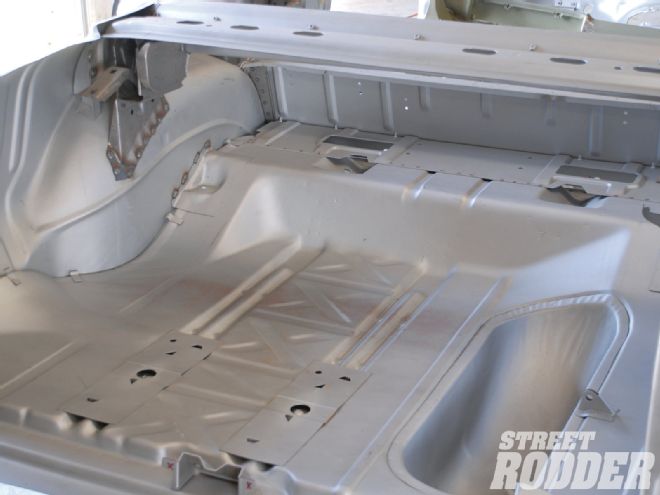 Looking from the rear forward into the trunk area we can see the decklid hinges and their mounting boxes hanging from the panel connecting the quarter-panels.
Looking from the rear forward into the trunk area we can see the decklid hinges and their mounting boxes hanging from the panel connecting the quarter-panels.
When we were at Real Deal Steel in Sanford, Florida, Sondles came down from Bright, Indiana, with his new gasser frame and mounted a two-door hardtop body on that chassis. Woody’s is a dealer for Real Deal Steel so it was only a natural that Sondles would develop a great gasser chassis for these cars. Woody’s also offers at least two other Tri-Five Chevrolet chassis—one based on stock-style suspension and another for the Pro Touring set, but for now let’s take a quick look at the gasser frame. Yes, the reproduction ’57 Chevrolet steel body and frame have arrived and we’re looking forward to a stream of hot rod Chevys rolling out of garages again, just like they did in the ’60s.